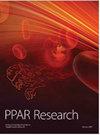过氧化物酶体增殖物激活受体γ通过mTOR途径介导的自噬调节绵羊滋养细胞脂质代谢
IF 3.1
3区 医学
Q2 MEDICINE, RESEARCH & EXPERIMENTAL
引用次数: 0
摘要
过氧化物酶体增殖体激活受体γ (PPARγ)是一种关键的核受体转录因子,在胚胎附着期间在滋养细胞中高度表达,并伴随细胞快速增殖和脂质积累增加。我们之前的研究表明,在PPARγ激活后,细胞中的自噬途径被激活,伴随着脂质积累的增加。本研究利用PPARγ激动剂罗格列酮和抑制剂GW9662,以及自噬激活剂雷帕霉素和抑制剂3-甲基腺嘌呤,揭示了PPARγ参与绵羊滋养细胞脂质代谢的可能机制。药物治疗12 h、24 h、48 h后,采用Western blot检测细胞自噬相关蛋白水平,采用比色法检测细胞甘油三酯含量和MDA水平,采用免疫荧光法定位脂滴和溶酶体。我们发现PPARγ在一定时间内抑制STCs中哺乳动物雷帕霉素靶蛋白(mTOR)途径的活性,促进自噬和溶酶体形成的增加,并增强脂滴和甘油三酯的积累。与激活PPARγ功能的细胞相比,在激活PPARγ之前阻断自噬会阻碍STCs的脂质积累。雷帕霉素预处理细胞可促进细胞自噬,其结果与罗格列酮处理相似,而3-甲基腺苷抑制细胞自噬可减少溶酶体和脂质积累。基于这些观察,我们得出结论,PPARγ可以通过阻断mTOR途径诱导自噬,从而促进脂滴的积累和溶酶体的降解,为胚胎着床过程中滋养细胞的快速增殖提供能量基础。总之,本研究部分揭示了PPARγ、mTOR通路和自噬对滋养层细胞脂质代谢的分子调控机制,为进一步探索绵羊胚胎附着过程中滋养层细胞的功能调控网络提供了理论基础。本文章由计算机程序翻译,如有差异,请以英文原文为准。
Peroxisome Proliferator-Activated Receptor γ Regulates Lipid Metabolism in Sheep Trophoblast Cells through mTOR Pathway-Mediated Autophagy
Peroxisome proliferator-activated receptor gamma (PPARγ) is a key nuclear receptor transcription factor that is highly expressed in trophoblastic cells during embryonic attachment and is accompanied by rapid cell proliferation and increased lipid accumulation. We previously showed that the autophagy pathway is activated in cells after activation of PPARγ, accompanied by increased lipid accumulation. In this study, we used PPARγ agonist rosiglitazone and inhibitor GW9662, as well as autophagy activator rapamycin and inhibitor 3-methyladenine, to unravel the probable mechanism of PPARγ engaged in lipid metabolism in sheep trophoblast cells (STCs). After 12 h, 24 h, and 48 h of drug treatment, the levels of autophagy-related proteins were detected by Western blot, the triglyceride content and MDA level of cells were detected by colorimetry, and the lipid droplets and lysosomes were localized by immunofluorescence. We found that PPARγ inhibited the activity of mammalian target of rapamycin (mTOR) pathway in STCs for a certain period of time, promoted the increase of autophagy and lysosome formation, and enhanced the accumulation of lipid droplets and triglycerides. Compared with cells whose PPARγ function is activated, blocking autophagy before activating PPARγ will hinder lipid accumulation in STCs. Pretreatment of cells with rapamycin promoted autophagy with results similar to rosiglitazone treatment, while inhibition of autophagy with 3-methyladenine reduced lysosome and lipid accumulation. Based on these observations, we conclude that PPARγ can induce autophagy by blocking the mTOR pathway, thereby promoting the accumulation of lipid droplets and lysosomal degradation, providing an energy basis for the rapid proliferation of trophoblast cells during embryo implantation. In brief, this study partially revealed the molecular regulatory mechanism of PPARγ, mTOR pathway, and autophagy on trophoblast cell lipid metabolism, which provides a theoretical basis for further exploring the functional regulatory network of trophoblast cells during the attachment of sheep embryos.
求助全文
通过发布文献求助,成功后即可免费获取论文全文。
去求助
来源期刊

PPAR Research
MEDICINE, RESEARCH & EXPERIMENTAL-
CiteScore
6.20
自引率
3.40%
发文量
17
审稿时长
12 months
期刊介绍:
PPAR Research is a peer-reviewed, Open Access journal that publishes original research and review articles on advances in basic research focusing on mechanisms involved in the activation of peroxisome proliferator-activated receptors (PPARs), as well as their role in the regulation of cellular differentiation, development, energy homeostasis and metabolic function. The journal also welcomes preclinical and clinical trials of drugs that can modulate PPAR activity, with a view to treating chronic diseases and disorders such as dyslipidemia, diabetes, adipocyte differentiation, inflammation, cancer, lung diseases, neurodegenerative disorders, and obesity.
 求助内容:
求助内容: 应助结果提醒方式:
应助结果提醒方式:


